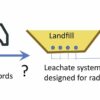by Dr Soheil Sabri, Professor Stephan Winter and Professor Abbas Rajabifard, University of Melbourne
Natural disasters like floods and heat waves demonstrate the real lack of control people have over the environment—although some of those disasters may actually be a consequence of human decisions and carelessness.
An increase in the frequency and severity of natural disasters has shone a spotlight on the urgent need for greater urban sustainability and “digital twins” technology is taking a leading role in tackling this challenge.
Defined as computer models of physical processes or replicas of physical entities, a digital twin is essentially a realistic and accurate virtual model.
Benefits of a digital twin
Digital twins offer promise as important tools for urban sustainability because they allow researchers to recreate a specific city environment and replicate the factors or processes that affect it, like traffic or emissions.
Digital twins can also be coupled with sensors in the environment, providing real-time data for detailed monitoring.
Researchers can then use AI to learn about those processes and how they affect the environment, predict future conditions and impacts, and so enable sustainable decision-making.
Our critical examination of digital twins and their potential in the world of urban sustainability shows these recent technological developments have proven financial and sustainability benefits for public and private organizations.
We showed that digital twins can make resource allocation more efficient by monitoring the real-time dynamic data of physical assets and then examining their performance in different virtual environment scenarios.
For example, by measuring and simulating the stormwater capacity of new road networks, waste and loss could be reduced by integrating historical and real-time sensor data and using that combined data to create a water-sensitive urban design.
Current barriers to digital engineering
But despite urban digital twins (UDT) leading the way in tackling technological, ethical and socio-technical issues, there are barriers to its application. So how can this technology be harnessed to support urban sustainability?
The success of UDT technology depends on timely and two-way communication between the physical and digital environments—without any compromises.
The first factor we have identified is a lack of digital literacy of many decision-makers, which results in less appreciation of digital technologies and therefore little contribution to their advancements in both research and financial resources.
It follows then that the more we can achieve technological readiness, the greater the possibility of adopting digital technologies in organizations or day-to-day activities.
And lastly, standards and shared data models are needed so that important data doesn’t remain in silos.
According to professional associations including the Institute of Surveying and Spatial Sciences (SSSI) in Australia, Standards Australia, Engineers Australia and the Planning Institute of Australia (PIA), standardization plays a vital role in developing a common language, process and data models across stakeholders and jurisdictions.
The Principles for Spatially Enabled Digital Twins for Built and Natural Environment developed by the Australia New Zealand Spatial Information Council, highlight the role of standards in managing information and data, UDT interoperability, privacy and security.
Trusting AI
An issue for many industries is that algorithmic decisions may be questioned and doubted due to accountability and transparency concerns.
Our recent research, published in Nature Sustainability, highlighted the vital role of explainable AI (XAI), or AI capable of explaining its results, in improving trust and transparency of AI-based decisions.
XAI addresses the challenge created by the “black box” concept where even the AI developers cannot explicitly explain why AI arrived at a specific result or decision.
Finally, current digital technologies only measure the objective aspects of urban entities and focus on the physical aspects of the city, like building height, tree canopy, type of land use and density, three-dimensional buildings, urban redevelopment visualization and building energy assessment.
However, cities are a combination of objective (physical and functional) and subjective (social construction and place experience) characteristics.
While some research has demonstrated new capabilities for measuring place quality, equitable access to facilities and the sociability of urban spaces, system-wide simulations and practical applications are still deficient and should be a key focus of future research to prevent ill-informed decisions and strategies based on inaccurate models.
Combining expertise to create digital cities
Because the applications of digital cities are so far-reaching, so is the expertise behind them.
By merging IT and engineering professionals with policymakers, end-users and planning and building experts, we can better leverage the value of digital technologies, address future challenges and return the current investments to the community.
Australian state governments have already started to draw on digital twin capabilities to better service the community. The NSW Spatial Digital Twin facilitated a cross-organizational, collaborative digital workflow for the entire state. It aggregates and visualizes location information in a dynamic and multi-dimensional model of the real world.
The Victorian Government secured $37.4 million to develop the Digital Twin Victoria platform to collate a mass of 2D, 3D and live data in a single online platform.
This project was motivated by the Government’s pilot digital twin project in Fishermans Bend, carried out in collaboration with the University of Melbourne and other stakeholders.
We know that a digital twin should be more than a replica: it should be coupled with physical processes or entities into a cyber-physical-social system.
Such a system may function more like a brain than a twin—with nerves that sense, with an agency that can change the physical or the digital system, and with moderation mechanisms to preserve the equilibrium of the physical and digital system.
We have started to upskill, create awareness among professionals, managers and executives, and educate the future workforce about digital twin technology. Our new education programs, like the Master of Digital Infrastructure Engineering and the Graduate Certificate of Digital Engineering (Infrastructure), address the technological, ethical and socio-technical challenges.
We have also collaborated with the industry to identify future digital engineering demand for the Australian and global infrastructure sector, which is booming and progressively adopting digital tools like Building Information Modeling (BIM), the Internet of Things (IoT) and virtual reality.
Leveraging our research and development of emerging technologies, in addition to these education programs, creates a new capability for future skill sets to integrate digital data with statistics, machine learning and data simulations.
The aim is simple—to engage better with communities and communicate physical and social processes, patterns and predictions in the design of sustainable future cities.
More information:
Asaf Tzachor et al, Potential and limitations of digital twins to achieve the Sustainable Development Goals, Nature Sustainability (2022). DOI: 10.1038/s41893-022-00923-7
Provided by
University of Melbourne
Citation:
Digital technologies to better predict future city environments may be key tool in sustainable urban design (2023, March 2)



